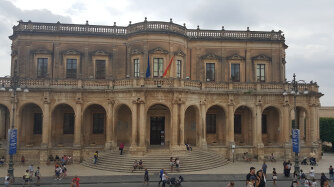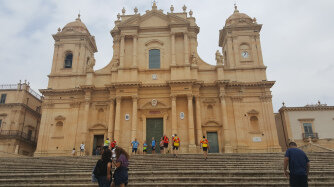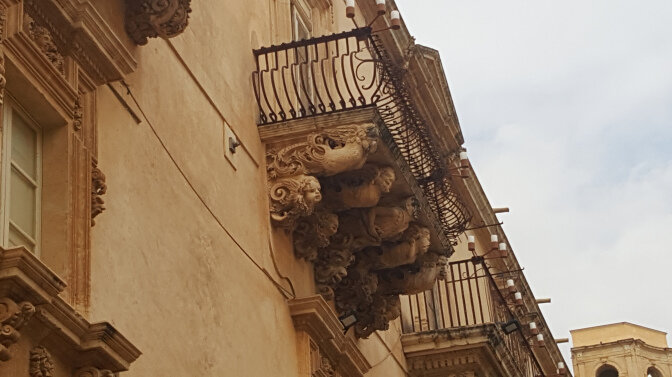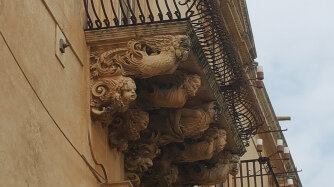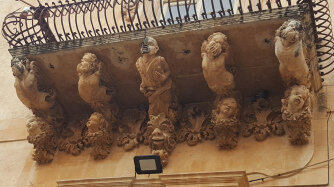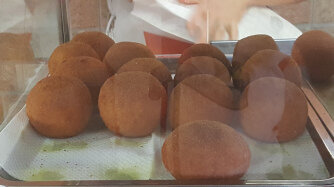The Road to Noto
What a great day!! It is our first day of riding and it has reminded me of why I love these trips so much. We left Syracuse this morning headed south-west toward the town of Noto. It was a short 34 miles, which I guess is a great way to start the trip. We don’t want to attempt anything too intense and the terrain was relatively flat, very little elevation gain. The sky was overcast as we began our travels making for a cool start to the day.
What I love about cycling Italy is that you get to see parts of the country you would not otherwise experience. We stopped after a few kilometers at a place known for the gratina. This actually reminded me of Italian Ice that I would get back in New York. It was cold and sweet, a refreshing treat after cycling. Unfortunately, we had not really cycled all that far. There were many times later in the day when I wished for that treat. Note that gratina should not be mistaken for Hawaiian or Shaved ice. The big difference between gratina is not shaved. As the gratina is frozen the ice is continuously broken up so that it stays in a state of slush from its inception.
We passed through small beachside communities and small fishing villages, seeing a way life is lived which is far from the typical tourist traps. We even passed an old abandoned tuna canning factory, a tonara as they are called here. It wasn’t that much to see, but it was a reminder of the area’s economic past.
Abandoned Tonora
Our destination for the day was the city of Noto. Noto has been around for quite some time, once known as Netum, it has found its way into ancient legends. You may recall the story of Daedalus and his son Icarus where they escape imprisonment from a tower in Crete by making wings with feathers attached by wax. Icarus, despite his father’s warnings, flew too close to the sun causing the wax that held the feathers to melt. As the feathers fell from the wings, the son fell into the sea. Daedalus survived the flight over the Ionian Sea ultimately settling in the city of … you guessed it … Noto!! This must have been quite the place in the old days, turns out Hercules came here after the completion of his seventh task. There were a number of other interesting people who lived here, people who were not part of legend, such as the Italian historian Giovanni Aurispa, architect Matteo Carnelivari, and composer Mario Capuana.
All this, however, is not the most interesting thing about Noto. You see, in 1693 the town was totally destroyed by a massive earthquake that hit the area. Since then the town has been rebuilt using a nice orderly grid system. More importantly, when they rebuilt the city they employed architects such as Rosario Gagliardi and Franceso Sortino masters of the style known as Sicilian Baroque. The architecture of the town is so beautiful it is known as The Stone Garden and has been named by UNESCO as a World Heritage Site.
Most of the monuments in Noto are in the Corso Vittorio Emanuele which you can enter via the Porto Reale which in itself is a work of art. There are more than 30 churches in the city, with the most prevalent being La Chiesa di San Nicolò. Both the exterior and interior of these churches are beautiful. As I side note, it is a great place to run stairs, there are a lot of them leading up to the cathedral.
Porto Reale
Interestingly, each of these churches has a convent associated with it. Think of it 30 churches each with a convent in a relatively small town. That is a great many convents. Well, it turns out that back in the old days fathers would give their second daughters to the church who would, in turn, serve as nuns. The young women did not have a choice back in those days. That was the role in which society had cast them.
The windows on these convents have bars. They called these barred windows jealousy windows, at least that is what one person told me. The bars kind of bow out towards the bottom to allow someone from within to look down on the street. I was told that this enabled the young nuns to look out on the street where they would see old boyfriends from before they became nuns. Hence the name jealousy windows.
The city is like a wonderland, ornately carved buildings that are all well preserved. The doors, windows, and balcony supports are carved in all manner of decoration. Some are intricate flowers while others have creatures both real and imaginary. Many of the news buildings are carved out of soft tufa stone that has a lovely honey tone to them in the sunlight.
For lunch we had arancini. Or is it arancine? Both are correct but do you know the difference? This is the fun part. An arancino or arancina is a rice ball. If the rice ball is cone-shaped it is considered male, therefore we refer to it as an arancino, the plural of which is arancini. If the rice ball is round it is considered female, therefore, we refer to it as arancina, the plural of which is arancine. I am in a quandary, however, were oblong!!! So I still don’t know what to call them!!
We are staying at La Corte Del Sole which is a masseria. A masseria is a fortified farmhouse or country estate, similar to a plantation of the American South or a hacienda in Spain. They were fortified to protect against marauding pirates and invading Turks. It is much more than a farm, however, more like the heart of the great estates of the aristocracy. The term is derived from the Italian word masserizie which is defined as household furnishings, food stores, or belongings. I feel that staying at a masseria is a wonderful escape from the common hotel or country inn. Staying here gives me a real flavor for the past in a beautiful setting.
As the sunset over the olive tree-studded hills, we open bottles of full-bodied red Sicilian wines. We sat there drinking in not just the wine but the serenity of the moment. As we waited for dinner, we ate the aged cheeses and fruits of the area. There is something in the air of Italian evenings, as I breathe it in, I experience a sense of contentment I feel nowhere else. I wish you could all be here with me to experience this feeling.
Ciao Tutti!!



